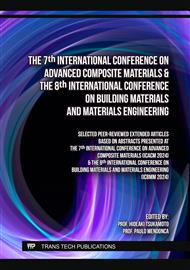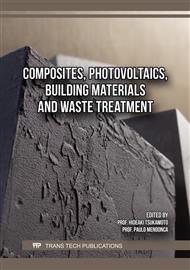[1]
Ellen Macarthur Foundation, "The New Plastics Economy: Rethinking the future of plastics," 2016. Accessed: Jul. 29, 2024. [Online]. Available: https://www.ellenmacarthurfoundation.org/the-new-plastics-economy-rethinking-the-future-of-plastics
DOI: 10.1002/j.1941-9635.2017.tb01670.x
Google Scholar
[2]
J. R. Jambeck et al., "Marine pollution. Plastic waste inputs from land into the ocean," Science, vol. 347, no. 6223, p.768–771, Feb. 2015.
DOI: 10.1126/SCIENCE.1260352
Google Scholar
[3]
McKinsey Center for Business and Environment, "Stemming the Tide: Land-based strategies for a plastic-free ocean," 2022.
Google Scholar
[4]
A. E. Schwarz, T. N. Ligthart, E. Boukris, and T. van Harmelen, "Sources, transport, and accumulation of different types of plastic litter in aquatic environments: A review study," Mar Pollut Bull, vol. 143, p.92–100, Jun. 2019.
DOI: 10.1016/J.MARPOLBUL.2019.04.029
Google Scholar
[5]
J. Seppälä, "Editorial corner – A personal view plastics – the good, the bad and the ugly?," Express Polym Lett, vol. 12, no. 10, p.855, Oct. 2018.
DOI: 10.3144/EXPRESSPOLYMLETT.2018.73
Google Scholar
[6]
W. Leal Filho et al., "An overview of the problems posed by plastic products and the role of extended producer responsibility in Europe," J Clean Prod, vol. 214, p.550–558, Mar. 2019.
DOI: 10.1016/J.JCLEPRO.2018.12.256
Google Scholar
[7]
E. J. Hunt, C. Zhang, N. Anzalone, and J. M. Pearce, "Polymer recycling codes for distributed manufacturing with 3-D printers," Resour Conserv Recycl, vol. 97, p.24–30, Apr. 2015.
DOI: 10.1016/J.RESCONREC.2015.02.004
Google Scholar
[8]
A. Ongen, "Methane-rich syngas production by gasification of thermoset waste plastics," Clean Technologies and Environmental Policy 2015 18:3, vol. 18, no. 3, p.915–924, Nov. 2015.
DOI: 10.1007/S10098-015-1071-1
Google Scholar
[9]
F. Gu, J. Guo, W. Zhang, P. A. Summers, and P. Hall, "From waste plastics to industrial raw materials: A life cycle assessment of mechanical plastic recycling practice based on a real-world case study," Sci Total Environ, vol. 601–602, p.1192–1207, Dec. 2017.
DOI: 10.1016/J.SCITOTENV.2017.05.278
Google Scholar
[10]
J. Maris, S. Bourdon, J. M. Brossard, L. Cauret, L. Fontaine, and V. Montembault, "Mechanical recycling: Compatibilization of mixed thermoplastic wastes," Polym Degrad Stab, vol. 147, p.245–266, Jan. 2018.
DOI: 10.1016/J.POLYMDEGRADSTAB.2017.11.001
Google Scholar
[11]
K. H. Ha and M. S. Kim, "Application to refrigerator plastics by mechanical recycling from polypropylene in waste-appliances," Mater Des, vol. 34, p.252–257, Feb. 2012.
DOI: 10.1016/J.MATDES.2011.08.014
Google Scholar
[12]
S. Chong, G. T. Pan, M. Khalid, T. C. K. Yang, S. T. Hung, and C. M. Huang, "Physical Characterization and Pre-assessment of Recycled High-Density Polyethylene as 3D Printing Material," J Polym Environ, vol. 25, no. 2, p.136–145, Jun. 2017.
DOI: 10.1007/S10924-016-0793-4
Google Scholar
[13]
M. A. Kreiger, M. L. Mulder, A. G. Glover, and J. M. Pearce, "Life Cycle Analysis of Distributed Recycling of Post-consumer High Density Polyethylene for 3-D Printing Filament," J Clean Prod, 2014.
DOI: 10.1016/j.jclepro.2014.02.009
Google Scholar
[14]
G. Mondragon, G. Kortaberria, E. Mendiburu, N. González, A. Arbelaiz, and C. Peña‐Rodriguez, "Thermomechanical recycling of polyamide 6 from fishing nets waste," J Appl Polym Sci, vol. 137, no. 10, Mar. 2020.
DOI: 10.1002/app.48442
Google Scholar
[15]
C. Alberti, R. Figueira, M. Hofmann, S. Koschke, and S. Enthaler, "Chemical Recycling of End‐of‐Life Polyamide 6 via Ring Closing Depolymerization," ChemistrySelect, vol. 4, no. 43, p.12638–12642, Nov. 2019.
DOI: 10.1002/slct.201903970
Google Scholar
[16]
M. A. Kamaruddin, M. M. A. Abdullah, M. H. Zawawi, and M. R. R. A. Zainol, "Potential use of plastic waste as construction materials: Recent progress and future prospect," IOP Conf Ser Mater Sci Eng, vol. 267, no. 1, Nov. 2017.
DOI: 10.1088/1757-899X/267/1/012011
Google Scholar
[17]
J. K. Appiah, V. N. Berko-Boateng, and T. A. Tagbor, "Use of waste plastic materials for road construction in Ghana," Case Studies in Construction Materials, vol. 6, p.1–7, Jun. 2017.
DOI: 10.1016/J.CSCM.2016.11.001
Google Scholar
[18]
A. Raut, M. Salman Patel, N. B. Jadhwar, U. khan, and P. W. Dhengare, "Investigating the Application of Waste Plastic Bottle as a Construction Material: A Review," Journal of Advance Research in Mechanical & Civil Engineering, vol. 2, no. 3, p.86–99, Mar. 2015.
DOI: 10.53555/NNMCE.V2I3.362
Google Scholar
[19]
K. V. Wong and A. Hernandez, "A Review of Additive Manufacturing," ISRN Mechanical Engineering, vol. 2012, p.1–10, Aug. 2012.
DOI: 10.5402/2012/208760
Google Scholar
[20]
B. H. Jared et al., "Additive manufacturing: Toward holistic design," 2017.
DOI: 10.1016/j.scriptamat.2017.02.029
Google Scholar
[21]
V. Shanmugam et al., "Polymer Recycling in Additive Manufacturing: an Opportunity for the Circular Economy," Materials Circular Economy, vol. 2, no. 1, p.11, Dec. 2020.
DOI: 10.1007/s42824-020-00012-0
Google Scholar
[22]
M. R. Khosravani and T. Reinicke, "On the environmental impacts of 3D printing technology," 2020.
DOI: 10.1016/j.apmt.2020.100689
Google Scholar
[23]
L. Lopes, L. Penazzato, D. C. Reis, M. Almeida, D. V. Oliveira, and P. B. Lourenço, "A Holistic Modular Solution for Energy and Seismic Renovation of Buildings Based on 3D-Printed Thermoplastic Materials," Sustainability 2024, Vol. 16, Page 2166, vol. 16, no. 5, p.2166, Mar. 2024.
DOI: 10.3390/SU16052166
Google Scholar
[24]
M. V. Sarakinioti, M. Turrin, T. Konstantinou, M. Tenpierik, and U. Knaack, "Developing an integrated 3D-printed façade with complex geometries for active temperature control," Mater Today Commun, vol. 15, p.275–279, Jun. 2018.
DOI: 10.1016/j.mtcomm.2018.02.027
Google Scholar
[25]
G. Grassi, S. Lupica Spagnolo, and I. Paoletti, "Fabrication and durability testing of a 3D printed façade for desert climates," Addit Manuf, vol. 28, p.439–444, Aug. 2019.
DOI: 10.1016/J.ADDMA.2019.05.023
Google Scholar
[26]
H. Strauß and U. Knaack, "Additive Manufacturing for Future Facades: The potential of 3D printed parts for the building envelope," Journal of Facade Design and Engineering, vol. 3, no. 3–4, p.225–235, Jun. 2016.
DOI: 10.3233/FDE-150042
Google Scholar
[27]
X. Tian, T. Liu, Q. Wang, A. Dilmurat, D. Li, and G. Ziegmann, "Recycling and remanufacturing of 3D printed continuous carbon fiber reinforced PLA composites," J Clean Prod, vol. 142, p.1609–1618, Jan. 2017.
DOI: 10.1016/j.jclepro.2016.11.139
Google Scholar
[28]
I. Anderson, "Mechanical Properties of Specimens 3D Printed with Virgin and Recycled Polylactic Acid," 3D Print Addit Manuf, vol. 4, no. 2, p.110–115, Jun. 2017.
DOI: 10.1089/3DP.2016.0054
Google Scholar
[29]
G. Atakok, M. Kam, and H. B. Koc, "A REVIEW OF MECHANICAL AND THERMAL PROPERTIES OF PRODUCTS PRINTED WITH RECYCLED FILAMENTS FOR USE IN 3D PRINTERS," https://doi.org/10.1142/S0218625X22300027, vol. 29, no. 2, Nov. 2021.
DOI: 10.1142/S0218625X22300027
Google Scholar
[30]
A. Al Rashid and M. Koç, "Additive manufacturing for sustainability and circular economy: needs, challenges, and opportunities for 3D printing of recycled polymeric waste," 2023.
DOI: 10.1016/j.mtsust.2023.100529
Google Scholar
[31]
F. Ferrari, C. Esposito Corcione, F. Montagna, and A. Maffezzoli, "3D Printing of Polymer Waste for Improving People's Awareness about Marine Litter," Polymers (Basel), vol. 12, no. 8, p.1738, Aug. 2020.
DOI: 10.3390/polym12081738
Google Scholar
[32]
R. Barboza, H. Daruari, A. Rocha, M. Carvalho, and P. Mendonça, "Identification of waste potential from maritime activity - Incorporating polyethylene cables into building construction," Materials Science Forum, vol. 1116, p.131–138, Mar. 2024.
DOI: 10.4028/P-H5JGDW
Google Scholar



